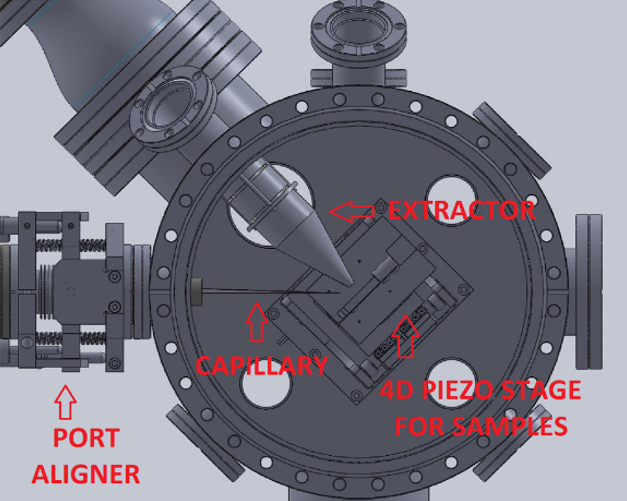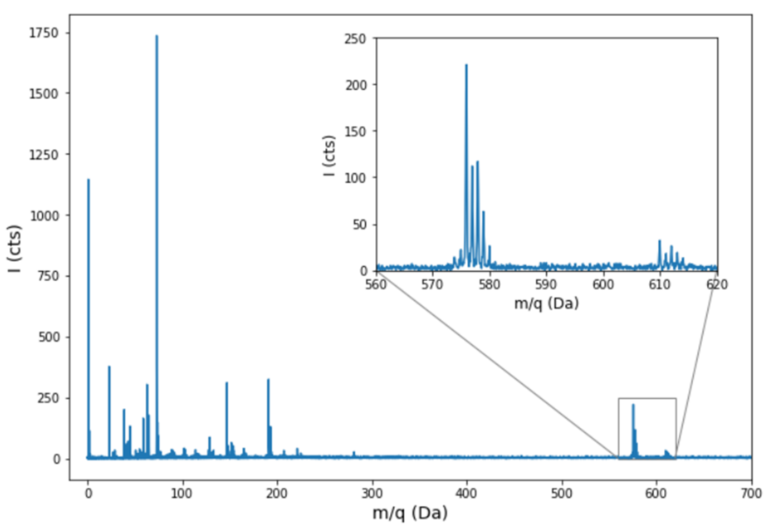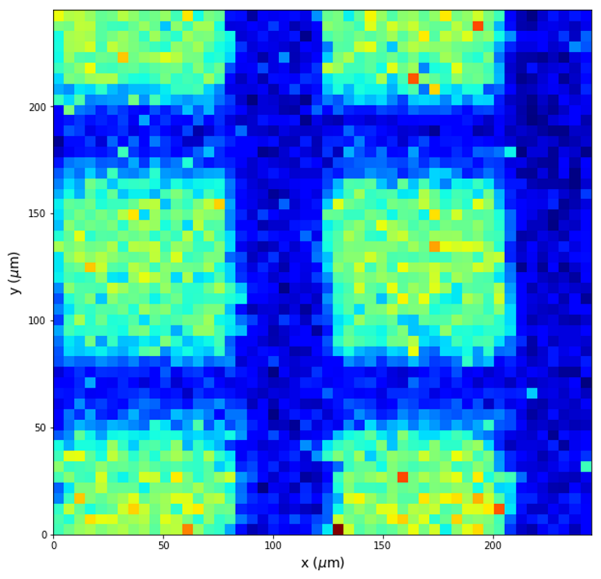Time-of-Flight Secondary Ion Mass Spectrometry (TOF-SIMS) is an analytical technique used for the atomic and molecular speciation of various samples. In TOF-SIMS, secondary ions are sputtered from the sample surface by the ion beam bombardment, and after the ionisation process, accelerated towards the TOF analyser for mass identification. Energy of the desorbed ions/molecules is in the range of the few eV, which makes TOF-SIMS a surface sensitive technique (only ions desorbed from the first few monolayers from the sample can be detected). Since the ionisation process of desorbed ions/molecules strongly depends on the surface conditions and sample matrix, TOF-SIMS is mostly used only for the qualitative analysis.
In the world of the mass spectrometry of organic materials, the “holy grail” is to get as many detected intact molecules per incoming ion, and to keep detected number of fragments as low as possible. One of the ways to achieve this is to use primary ions with the energies in the MeV range. Contrary to the conventional TOF-SIMS systems, where the keV ions are used for the molecular desorption, and sputtering is done through the hard-nuclear collisions, sputtering by MeV ions is mainly done by the “soft” electron collisions, leading to the higher yields of the intact molecular ions. Since the yield of the intact secondary molecules is directly proportional to the electronic stopping power, for TOF-SIMS analysis, heavy ion beams with high as possible energies should be used. The new chamber for TOF-SIMS is installed at the 0° beamline with no restriction on the acceptable ion mass and energy (Figure 1) [1]. Thus, the full potential of the method, using heavy MeV ions, can be exploited.
Figure 1. Inside view of the Capillary MeV-TOF SIMS setup.
Technical specifications:
- MeV ions are focused to the micrometre spot dimension by the extruded glass capillary with outlet opening of ~ 5 µm.
- Desorbed molecules are mass analysed by the TOF Reflectron analyser.
- Micro-molecular imaging is done by moving the sample attached to the precise 4D piezo stage.
- TOF measurements can be performed in two modes:
- Transmission mode for thin samples, where PiN diode placed behind the target is used for a START signal.
- Pulsed extraction mode for thick samples, where secondary electrons emitted from the sample surface are used for the START signal.
- Spatial resolution of the existing setup (5 µm capillary) is 10 µm in the x-direction and 20 µm in the y-direction. Factors limiting spatial resolution are beam divergence and beam halo.
- Mass resolution M/ΔM≈2500 for M≈600 Da
Sample requirements:Capillary MeV TOF-SIMS is used for the 2D molecular imaging of organic/biological samples. All samples should be manipulated only by the metallic tweezers and kept in the aluminium foil (plastic containers should be avoided due to the possible contamination with PDMS). Biological samples should be prepared by following procedure: plunge freeze → cryo-sectioning → freeze drying. For the transmission mode, cryo-sectioned samples should be 5 µm thick and placed on the transparent 100 nm thick Si3N4 window.
Example:Typical spectra of Phthalocyanine Blue (transmission mode), with mass resolution better than M/ΔM=2500, is shown in Figure 2 [1].
Figure 2. MeV TOF-SIMS spectra of Phthalocyanine Blue PB15:1
An example of the 2D SIMS image of Leucine evaporated on the carbon-coated copper grid (200 mesh) is presented in Figure 3.
Figure 3. 2D image of Leucine 2D SIMS image of Leucine evaporated on the carbon coated copper grid (200 mesh)
REFERENCES
[1] Marko Brajković, Marko Barac, Donny Cosic, Iva Bogdanović Radović, Zdravko Siketić, Development of MeV TOF-SIMS capillary microprobe at the Ruđer Bošković Institute in Zagreb, Nuclear Instruments and Methods in Physics Research Section B: Beam Interactions with Materials and Atoms, https://doi.org/10.1016/j.nimb.2019.10.006.





